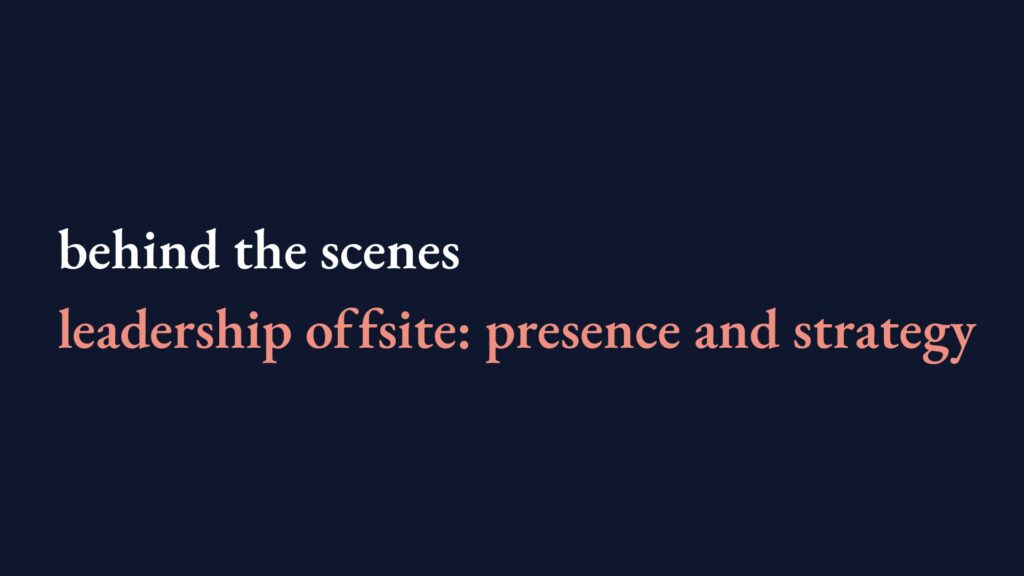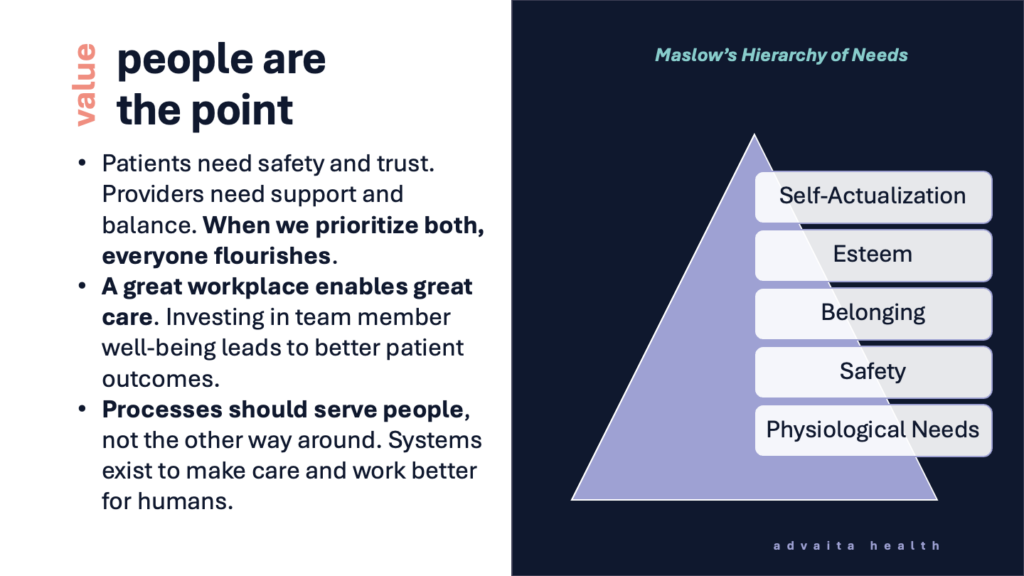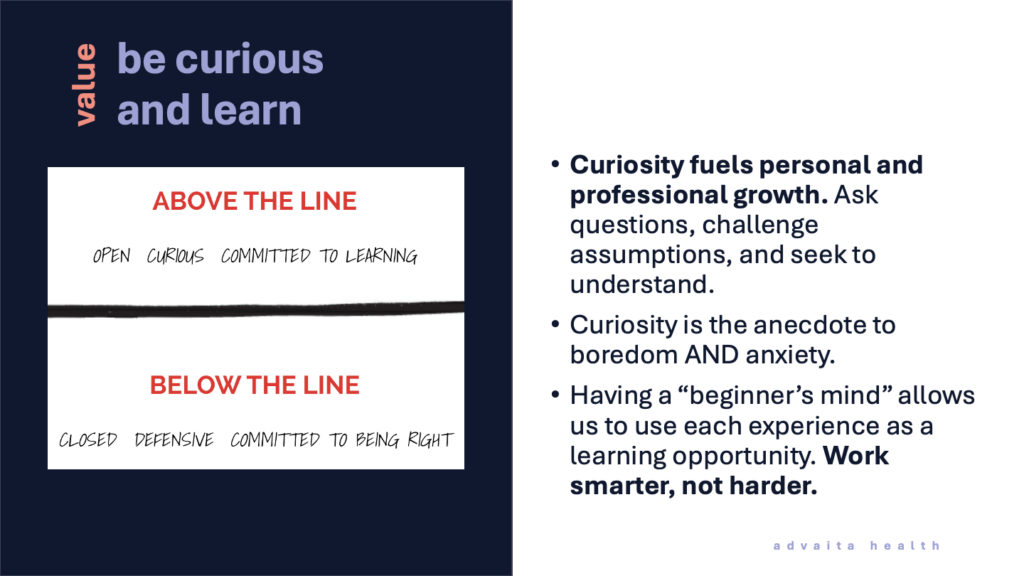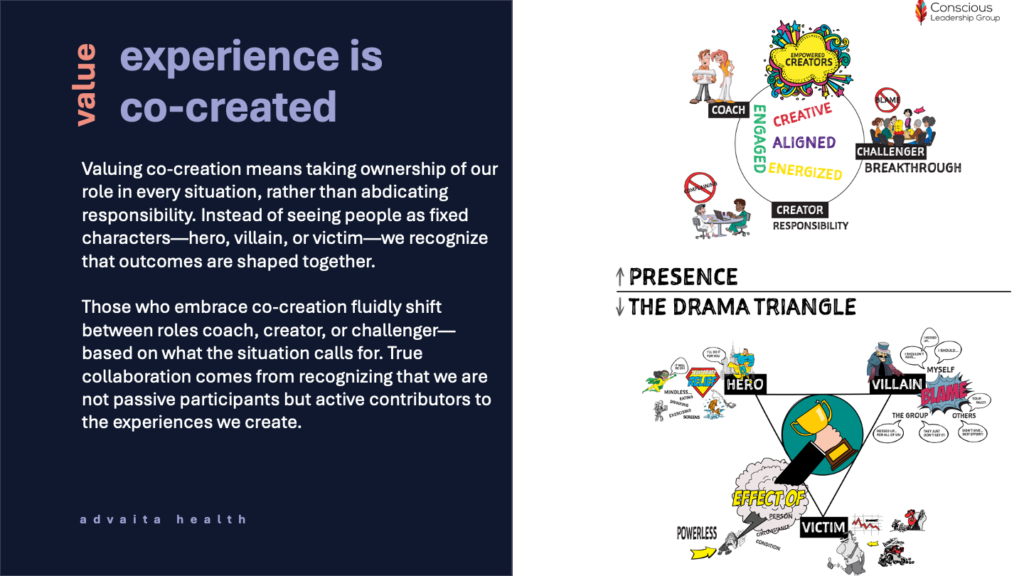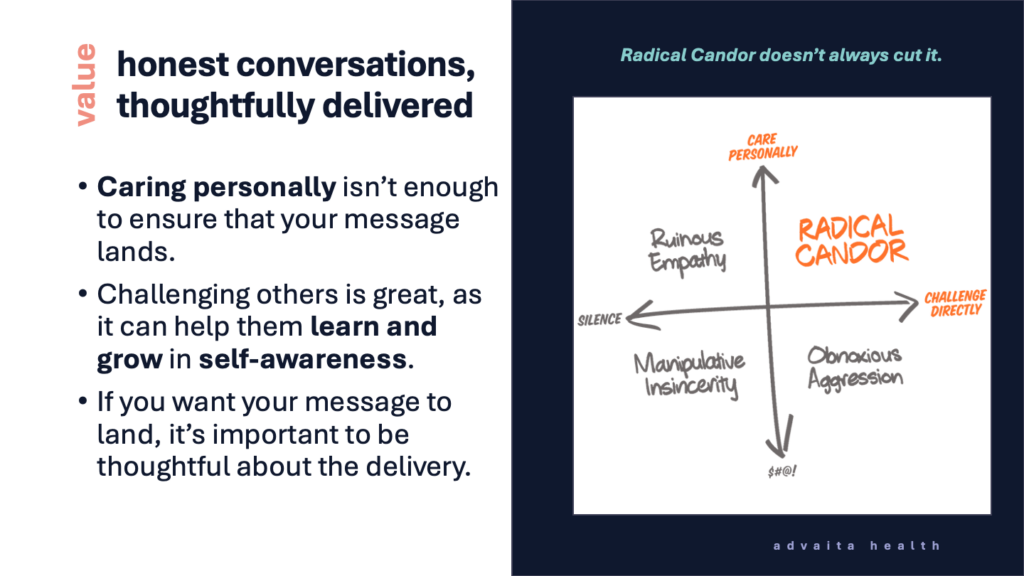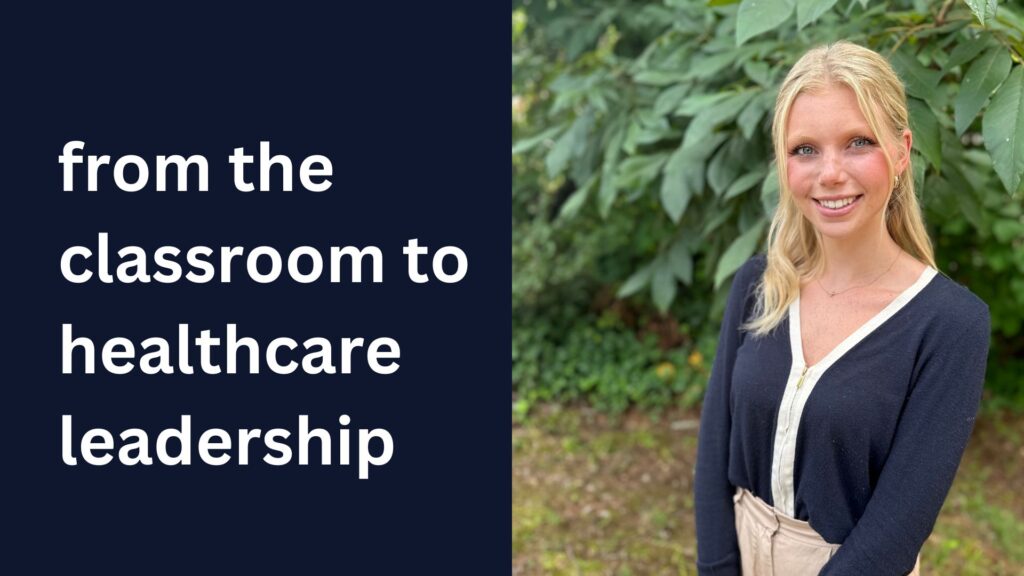There’s a lot we can’t control in healthcare — staffing challenges, policy shifts, the chaos of a Tuesday. But one thing we can control is how we show up. And how we show up — through our values, our vision, and our culture — shapes everything else.
That’s why I stay personally involved in onboarding. We use it as a moment to ground new team members in who we are, what we believe, and where we’re going. It’s one of the only times we collectively slow down long enough to reflect on what actually matters. This isn’t just orientation — this is culture in practice.
It’s never perfect. Sometimes I’m juggling 37 tabs and talking off-script. But doing it imperfectly is better than skipping it. If we want to build something meaningful, we have to commit to reinforcing what we stand for — from day one.
What’s in a Name?
We chose the name Advaita intentionally. It’s a Sanskrit word that means “non-dual” — the idea that what seems separate is actually interconnected. That principle shapes how we operate. We’re not just building a practice — we’re building a healthcare system where care delivery, operations, and business functions work together in alignment. That’s why we bring key capabilities in-house — marketing, technology, finance. It’s more work, but it creates stronger, more cohesive outcomes.
We pair that with the concept of eudaimonia — a Greek word for human flourishing. Flourishing is the thread that runs through everything we do. For our patients, that means moving from suffering to something more whole. But it doesn’t stop there. If our team doesn’t have the space to grow, feel seen, and do meaningful work, we’ve missed the point. Flourishing is for everyone in this system — not just the people receiving care.
Vision: The Long Game
Our vision is clear:
We are building an integrated healthcare system in the Southeast that serves as a medical home — delivering whole-person care that improves patient outcomes, supports providers, and strengthens communities.
To make that real, we align everything — our team, our systems, our goals — around this shared purpose. We’re leveraging data, technology, and an exceptional team to make high-quality care more affordable and accessible. And we’re not stopping at patient care. We want to shape the system itself — influencing policy, expanding access, and building a model that can scale with integrity.
That’s what we mean by playing the long game. We believe healthcare should serve everyone involved — patients, providers, team members, and partners. That requires a stakeholder-centric approach. We’re not interested in blaming the system or casting ourselves as victims of insurance companies. We’re here to be co-creators — to work within the system while pushing for something better. Eventually, we plan to have a seat at the table where decisions about the future of healthcare are made.
This is healthcare designed for human flourishing — at scale.
Mission: From Suffering to Flourishing
Our mission is simple: to move people from suffering to flourishing.
It sounds straightforward, but it holds a lot of weight. Everyone comes into healthcare with different philosophies and approaches. But almost anyone in this space can agree — people are suffering, and we want to help them heal.
This mission resonates with me because I’ve seen suffering firsthand — in friends, in family, in myself. And I’ve seen what it looks like when people are given the space and support to flourish. That’s what we’re aiming for — not just clinical improvement, but transformation.
A Culture of Growth: The DDO Mindset
This is why we operate as a Deliberately Developmental Organization (DDO). We pulled this framework from the book An Everyone Culture, and it’s changed how we think about work.
The core belief is this: work should be a place where people grow, not just perform.
Around here, we ask questions like “What are your goals?” and “How is this role serving you?” That’s not a one-off onboarding conversation. It’s embedded in how we lead, how we manage, and how we evaluate success.
If we can align your growth with the company’s growth, everybody wins. That’s when work feels meaningful — and when culture becomes more than just words.
Values: Our Compass
We’ve designed our values to be actionable — things we can train on, practice, and reflect on together. They’re not about being perfect. They’re about being intentional.
1. Experience Is Co-Created: We all shape the environment we’re in. Culture isn’t something handed down — it’s something we co-create every day. We use tools like the Drama Triangle and Presence Triangle to notice how we’re showing up and take responsibility for our energy, not just our outcomes.
2. Grow in Self-Awareness: None of us are finished products. Tools like the Johari Window and the “Above or Below the Line” model help us build a shared language around feedback and reflection. Growth happens when we stop defending ourselves and start learning from what’s in front of us.
3. Honest Conversations, Thoughtfully Delivered: We believe in radical candor — caring personally and challenging directly. But we go further. We want those conversations to be thoughtful, kind, and clear. We use tools like the clearing model to resolve tension, build trust, and avoid the quiet buildup of resentment.
4. Be Curious and Learn: Curiosity keeps us open. It invites collaboration and lowers defensiveness. One of the most helpful shifts I’ve made is learning not to walk into every room with a fully baked answer — but to solve things with people, not for them.
5. People Are the Point: Processes, systems, and metrics matter — but only because they serve people. Whether it’s a frustrating workflow or a difficult patient interaction, we stay anchored in who it’s affecting and why it matters.
Why I Lead Onboarding
Culture doesn’t take care of itself. It’s built through consistent actions, not just values written on a wall. That’s why I personally lead our onboarding presentation. Not because I need to be the face of everything — but because I believe the tone at the top matters. Culture is lived, not delegated.
As a CEO, it’s easy to get pulled into strategy, growth plans, financials — all the things that feel urgent. But the things that make us healthy and aligned? They don’t usually scream for attention. They require slowing down, committing to process, and investing in people — even when it’s not convenient.
You can’t fake culture. You have to live it. And that starts here.
There’s a lot we can’t control in healthcare — market conditions, staffing challenges, a hundred unexpected fires on a Tuesday. But one thing we can control is how we show up. And the way we show up — our values, our vision, our culture — shapes everything else.
We’ve been putting more intention into the parts of our company that matter most — our values, vision, and culture. These aren’t just words we throw on a website. They shape how we hire, how we lead, and how we make decisions. That alignment starts from the very beginning, and onboarding is one of the key moments to reinforce what we stand for. It’s easy to let things like a culture presentation fall off the calendar — especially when it’s not polished, or when there’s a long list of other urgent work. But I’ve found that doing it imperfectly is far better than not doing it at all.
This is one of the ways I stay personally involved. I see onboarding as more than just orientation — it’s a chance to pause and say, this is what matters here. It’s one of the only moments where everyone slows down long enough to talk about who we are, what we believe, and where we’re going. And while it won’t always be flashy, it’s part of building something grounded and intentional — something worth committing to.
What’s in a Name?
We chose the name Advaita for a reason. It’s a Sanskrit word that means “non-dual” — the idea that things that seem separate are actually part of a unified whole. That concept sits at the heart of how we think about our work. We’re not just building a healthcare company. We’re building an integrated system where clinical care, operations, and business functions aren’t siloed — they’re working in sync to create something stronger. That’s why we bring things in-house that most others outsource: marketing, finance, technology. It’s harder that way, but it’s more aligned. And alignment matters.
The other word we come back to often is eudaimonia — the Greek concept of human flourishing. It’s not just about feeling good. It’s about growth, purpose, and a life well-lived. For us, that means helping patients move from suffering to flourishing — but also making sure the people who work here are growing, too. We’re not interested in building a business where the work is technically successful but people feel stuck, small, or burned out. Flourishing has to be for everyone.
The Long Game
We’re not just running a practice — we’re building an integrated healthcare system rooted in human flourishing. Our long-term vision is to create a true medical home: delivering whole-person care that improves patient outcomes, supports our team, and strengthens the communities we serve.
We’re starting in the Southeast, but our ambition is broader. By leveraging data, technology, and the development of a world-class team, we’re making high-quality care more affordable and accessible — and building something that can scale with integrity. Our work doesn’t stop at the clinic door. It includes shaping policy, rethinking how care is delivered, and ensuring more people get what they need to truly thrive.
This is what we mean when we talk about playing the long game. We believe healthcare should serve everyone involved — patients, providers, team members, partners — and that only happens through a stakeholder-centric approach. That means taking responsibility for what we can control, even when the system feels stacked against us. We don’t see ourselves as victims of insurance companies or bureaucracy. We see ourselves as co-creators of something better — and we’re building the kind of organization that will have a seat at the table when decisions about the future of healthcare are being made.
This is healthcare designed for human flourishing — at scale
Our Mission & Your Role in Flourishing
Our mission is simple: to move people from suffering to flourishing. That language is intentional. It’s broad enough to include different approaches to care, but clear enough to center everything we do.
It resonates with me not just as a leader, but as a person who’s seen what suffering looks like — in friends, family, our communities, and in myself. Flourishing isn’t some lofty, abstract goal. It’s the ability to live well, to feel supported, to grow into your potential. And I believe healthcare should be a force that enables that — not just for patients, but for everyone in the system.
That’s why we’re building what’s called a Deliberately Developmental Organization (DDO) — an idea pulled from the book An Everyone Culture. The core belief is that work should be a place where people grow, not just perform. Around here, you’ll hear questions like “What are your goals?” or “How is this role serving you?” Those aren’t just nice things to ask — they’re part of how we operate.
I want everyone on this team to know what we’re trying to build as an organization and to have the space to pursue what they’re building for themselves. When those two things align — personal goals and organizational goals — that’s when the real magic happens. That’s when the work gets better, the culture gets stronger, and everyone wins.
Our Core Values
We’ve spent a lot of time thinking about our values — not as platitudes to put on the wall, but as practices we want to live into every day. These values are here to guide how we show up for our patients, for each other, and for ourselves. They’re also the foundation for how we train, lead, and grow.
These aren’t always easy to live out. But they matter. Because the way we work is the work.
1. Experience Is Co-Created
How we show up shapes the environment we’re in. Culture isn’t something separate from us — we’re all contributing to it in every conversation, meeting, and moment. Even when someone else is having a hard day, we get to choose how we respond. We use tools like the Drama Triangle and Presence Triangle to notice when we’re falling into blame, rescuing, or shutting down — and shift into more intentional ways of relating.
This value is about ownership — not just of outcomes, but of energy.
2. Grow in Self-Awareness
None of us are finished products. One of the best things we can do for ourselves — and the people we work with — is get better at seeing our own blind spots. We use models like the Johari Window and the “Above or Below the Line” framework to build shared language around reflection.
Above the line means being open, curious, and committed to learning. Below the line means being closed, defensive, and committed to being right. We all dip below the line sometimes. The key is noticing when we do — and having the courage to shift. Growth doesn’t happen by accident. It happens through practice.
3. Honest Conversations, Thoughtfully Delivered
We believe in radical candor — but we take it a step further. Yes, we need to challenge directly. But first, we have to care personally. And just as importantly, we need to communicate in ways that are thoughtful, respectful, and clear.
We’ve built tools into our culture — like the clearing model — to help us name tension instead of avoiding it. It might feel uncomfortable, but it’s how we build trust, prevent resentment, and stay in real relationship with one another. A team that talks honestly — and listens well — is a team that grows together.
4. Be Curious and Learn
Curiosity is one of the most underrated leadership skills out there. It lowers the ego, invites collaboration, and opens up new possibilities. Whether it’s a clinical challenge, a miscommunication, or a systems problem — asking what can I learn from this? gets us unstuck.
One of the best pieces of feedback I’ve ever gotten was to stop solving every problem before walking into the room. Bring people into the process. Let the solution emerge together. We’re not here to get it right all the time. We’re here to get better.
5. People Are the Point
Everything we do comes back to people. Not processes. Not systems. Not spreadsheets. It’s about the humans they’re meant to serve.
If something’s broken, we want to fix it — not because it’s inefficient in the abstract, but because it’s creating friction for someone on our team. If a patient is struggling, we care — not just because we’re supposed to, but because that’s why we’re here.
This is healthcare designed for human flourishing — and that includes the people doing the work.
Why This Matters
Culture doesn’t sustain itself. If we want to build something meaningful — something grounded, aligned, and worth being part of — then it has to be tended to. Not just with the right words, but with consistent actions. That’s why I stay involved in onboarding. It’s not because I have all the answers or because I need to be the face of everything — it’s because culture starts at the top, and I take that seriously.
As a CEO, it’s easy to get pulled into strategy, growth, operations — all the stuff that feels urgent. But the things that shape a healthy culture don’t always feel urgent — until they’re broken. Then it’s too late. So we commit to certain practices. We have conversations that aren’t always easy. We pause long enough to remind ourselves — and each other — why we’re doing this.
This isn’t about being perfect. It’s about being intentional. And when leaders show up with that kind of consistency — when we model the values we say we care about — it sets the tone for everything else.
This is the kind of organization I want to be part of. And I’m glad you’re here to help us build it.
